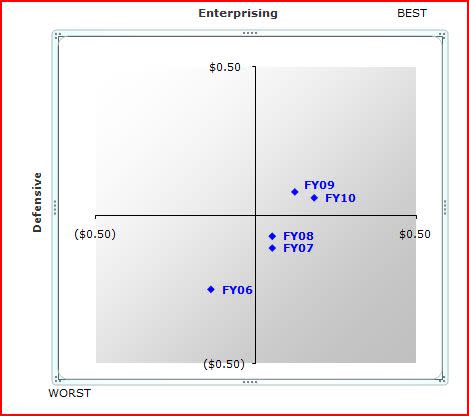8x8 Has High-Quality Earnings
8x8 (NAS: EGHT) reported $7 million in net income over the last four quarters. But how good are those earnings, really? Apparent profits on the income statement won't always tell you the whole story. Instead of looking just at the reported numbers, you need to find companies with authentic earnings power. So how do the earnings at 8x8 look?
It's earnings that count
In his book, It's Earnings That Count, Hewitt Heiserman explains how to determine the quality of a company's profits. First, he points out four key limitations of the traditional income statement:
Fixed capital investments are not fully expensed, but rather depreciated over time.
Investments in working capital are left off the income statement.
Intangible growth-generating expenditures (such as advertising) are immediately expensed, even though they pay off over time.
Retained earnings that are reinvested back in the business are not treated as an expense.
To compensate for these defects, Heiserman suggests that investors recalculate the income statement, creating both a defensive income statement and an enterprising statement. If a company can achieve profits on both statements, then that business has authentic earnings power. And that, explains Heiserman, can lead to safer and more profitable investments.
The defensive income statement
The defensive statement shows whether a company can self-fund and generate more cash from its operations than it uses. The defensive statement looks like a regular statement, but corrects for the first two limitations above. First, it expenses all capital investments in the year they're incurred. Second, the defensive statement treats a company's investments in working capital as if they were expenses. This statement is stringent in order to provide the most conservative look into the company's operations.
The enterprising income statement
The enterprising statement reveals whether the business can create value and turn shareholder money into even greater profit over time. It corrects for the second two limitations mentioned above. First, it treats R&D and advertising costs as capital assets, depreciating them over their useful lives. Second, the enterprising statement treats equity capital held on the balance sheet as an expense.
Here are the statements for 8x8 and a few peers over the last few years, divided into enterprising and defensive profits, respectively. We're looking for solidly profitable numbers that grow over time, in order to show authentic earnings power.
Company | 2010 | 2009 | 2008 | 2007 | |
|---|---|---|---|---|---|
8x8 | $0.18, $0.06 | $0.12, $0.08 | $0.05, ($0.07) | $0.05, ($0.11) | |
CenturyLink (NYS: CTL) | ($1.50), $1.29 | ($2.61), $0.22 | ($2.07), $1.19 | ($1.21), $0.43 | |
Cablevision Systems (NYS: CVC) | $1.62, ($3.41) | $1.24, $0.64 | $1.28, ($1.12) | $0.36, ($1.53) | |
Windstream (NAS: WIN) | ($0.46), $0.13 | ($0.07), $0.02 | $0.30, $0.33 | $0.22, $0.15 |
Source: Capital IQ, a division of Standard & Poor's. (Enterprising, defensive earnings.)
8x8 shows consistent improvement in its enterprising earnings since 2007, and it has also grown its defensive earnings over the same time period. Other peers are showing either negative enterprising or defensive earnings in 2010.
The earnings power chart
For an illustrative depiction of a company's earnings power, Heiserman recommends graphing the earnings from the defensive and enterprising statements, plotting enterprising profits along the horizontal axis and defensive along the vertical. I've done this for 8x8 below.

Ideally, you want to see the company generating both earnings figures in the upper right quadrant. A staircase of escalating earnings toward the upper right over time would be even better. That pattern would show that the company is consistently generating value and self-funding, two great signs of a winning company. As the chart demonstrates, 8x8 has shown a textbook example of high-quality earnings, consistently moving toward the upper right.
Foolish bottom line
The enterprising and defensive statements can provide you some key insights into a company's earnings power and quality. Just because a company doesn't make it into the upper right quadrant doesn't mean it can't be a good investment. But if it isn't at least moving toward the upper right, you'll want to dig in deeper to find out why. To keep an eye on these companies, add them to your watchlist:
Add 8x8 to My Watchlist.
Add Windstream to My Watchlist.
Add Cablevision Systems to My Watchlist.
Add CenturyLink to My Watchlist.
At the time thisarticle was published Jim Royal, Ph.D., does not own shares in any company mentioned here. Try any of our Foolish newsletter servicesfree for 30 days. We Fools may not all hold the same opinions, but we all believe thatconsidering a diverse range of insightsmakes us better investors. The Motley Fool has adisclosure policy.
Copyright © 1995 - 2011 The Motley Fool, LLC. All rights reserved. The Motley Fool has a disclosure policy.

